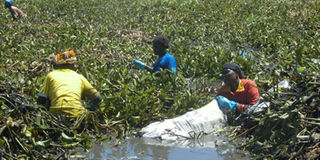Sh1.2bn for hyacinth power project

Water hyacinth in Lake Victoria. The weed has been blamed over the years for ever decreasing quantity of fish from the lake. PHOTO | JACOB OWITI | FILE
What you need to know:
- Harvesting and processing the water hyacinth will be a 24-hour task starting from early morning.
- Water hyacinth is mostly concentrated along the shore and has affected transport, fishing and tourism in Kisumu County.
- The weed has been blamed over the years for ever decreasing quantity of fish from the lake as firms remain on the spot over pollution that is said to promote its spread.
The water hyacinth on Lake Victoria may no longer be a menace with the purchase of a Sh500 million harvester.
The noxious weed will now be used to generate power through the machine, an Aquatic feed harvester.
The move is part of a multi-billion energy venture by a group of private investors, in a bid to resolve the water hyacinth invasion that has choked the economic potential out of the lake.
At a cost of Sh1.2 billion, the project is set to be launched in October this year and will be on 40-acre piece of land, acquired for the first phase.
“We bought land at Rare Beach along the Kisumu- Bondo road and construction is in the final stages,” Mr Sanjay Vadhera, one of the investors said.
Electricity for national grid
He is the founder and chief executive of Kenya Organic Research Centre for Excellence, which intends to use biodegradable waste to produce 120MW of electricity for the national grid as well as organic fertiliser.
18 families were paid Sh300,000 per acre as compensation while another 22 occupying an adjacent 40 acres will be relocated in the next phase.
The families are also set for free electricity connection to their homes and jobs at the plant when it opens.
“We will only import skills that are not available here since we intend to employ locals too.
“This is the product of intensive five-year research and we want to prove that the weed can be economically viable,” said Mr Vadhera.
Hyacinth covers 680 km²
Harvesting and processing the water hyacinth will be a 24-hour task starting from early morning.
The weed harvester can harvest up to 150 tonnes of hyacinth per day which translates to 2 hectares under the noxious weed.
“We plan to handle at least 150 tonnes in the first few months and increase this to 800 tonnes,” said Mr Vadhera.
A study established that the hyacinth covers 680 square kilometres of the lake greatly hampering economic viability of the world’s second largest fresh water lake.
Mr Vadhera and Mr Kanji were however quick to dispel fears that their project will want to sustain hyacinth growth as raw material.
“Our aim is to greatly reduce the weed then we will switch to alternative solid waste but again hyacinth grows very fast and it will take time to completely eradicate it,” Mr Kanji said.
Move to solid waste
The solid waste is to be sourced from the municipal council and various industries in and around western Kenya.
Local authorities are said to be lacking a clear means of effectively managing solid waste, with heaps of decomposing garbage evident in most towns.
Water hyacinth is mostly concentrated along the shore and has affected transport, fishing and tourism in Kisumu County.
The weed has been blamed over the years for ever decreasing quantity of fish from the lake as firms remain on the spot over pollution that is said to promote its spread.





